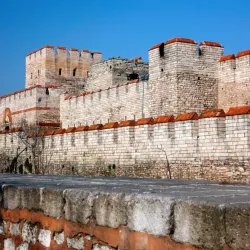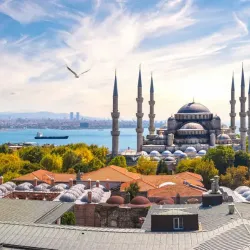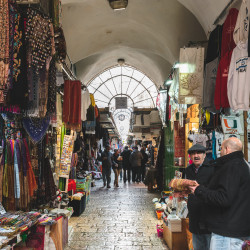Constantinople, a city steeped in history and strategic importance, had long been a coveted prize for empires. After centuries of Byzantine rule, the Ottoman Empire, under the leadership of Sultan Mehmed II, finally conquered the city in 1453. This pivotal event marked the end of the Byzantine Empire and the beginning of a new era for Constantinople, which would soon be known as Istanbul.
The Ottoman conquest of Constantinople was a significant turning point in the city's history. Mehmed II, also known as Mehmed the Conqueror, recognized the city's strategic and cultural value. He implemented policies to revitalize Istanbul, making it the capital of the Ottoman Empire. The city was transformed into a cosmopolitan center, attracting people from various ethnic and religious backgrounds.
One of the most significant changes under Ottoman rule was the conversion of the Hagia Sophia, a former Byzantine cathedral, into a mosque. This iconic structure became a symbol of Ottoman power and Islamic architecture. The Ottomans also constructed numerous mosques, palaces, and other public buildings, adding to the city's rich architectural landscape.

The Ottoman period saw significant economic and cultural development in Istanbul. The city became a hub for trade and commerce, connecting East and West. Its bazaars and markets were renowned for their diverse goods and vibrant atmosphere. The Ottoman Empire's patronage of arts and sciences also contributed to Istanbul's cultural flourishing.
However, Istanbul, like any great city, faced its share of challenges. Earthquakes, fires, and wars took their toll on the city's infrastructure and population. Despite these setbacks, Istanbul's resilience and enduring appeal allowed it to emerge stronger.
The Ottoman Empire's decline in the 19th and early 20th centuries led to significant changes in Istanbul. The city's cosmopolitan character was challenged by rising nationalism and political instability. However, Istanbul's historical and cultural heritage remained intact, ensuring its continued significance in the global landscape.
The Golden Age of Ottoman Architecture: The Era of Süleyman the Magnificent and Sinan
The reign of Süleyman the Magnificent (Süleyman the Lawgiver) marked a golden age for the Ottoman Empire, including Istanbul. Known for his patronage of arts and sciences, Süleyman commissioned numerous architectural projects that transformed the city's skyline.
A key figure in this era was the renowned architect Mimar Sinan. Under the patronage of Süleyman, Sinan designed and built some of Istanbul's most iconic structures, including the Süleymaniye Mosque, the Şehzade Mosque, and the Süleymaniye Complex, which included a mosque, madrasas, a hospital, and a tomb. These structures are renowned for their grandeur, intricate details, and innovative architectural techniques.

The Suleymaniye Mosque, in particular, is considered one of Sinan's masterpieces. Its imposing dome, graceful minarets, and spacious courtyard have made it a symbol of Ottoman power and Islamic architecture. The complex also includes a library, a hospital, and a tomb, demonstrating the Ottoman Empire's commitment to education, healthcare, and religious piety.
The legacy of Süleyman the Magnificent and Mimar Sinan continues to shape Istanbul's identity. Their architectural works not only beautify the city but also serve as a testament to the Ottoman Empire's cultural and artistic achievements.
The Ottoman Empire After Süleyman the Magnificent
The Ottoman Empire continued to thrive after the reign of Süleyman the Magnificent, though the empire gradually entered a period of decline. However, Istanbul continued to be a center of art, culture, and architecture.
One of the most iconic mosques built during this period is the Sultan Ahmed Mosque, also known as the Blue Mosque. Renowned for its stunning blue Iznik tiles, the mosque is a masterpiece of Ottoman architecture.
The Tulip Era, a period of cultural and artistic flourishing, saw the construction of numerous gardens and pavilions in Istanbul. The city's landscape was transformed with new architectural styles influenced by European trends. The construction of the Ahmet III Library in Topkapi Palace further enriched Istanbul's cultural heritage.

The 19th century marked a significant turning point for the Ottoman Empire, as it embarked on a series of reforms known as the Tanzimat Era. The Tanzimat reforms aimed to modernize the empire and align it with Western powers. This led to the introduction of Western-style architecture, infrastructure, and education systems.
After the collapse of the Ottoman Empire and the establishment of the Republic of Turkey in 1923, Istanbul continued to evolve. While it lost its status as the capital, it remained a vibrant city and a major cultural and economic center.
Today, Istanbul stands as a testament to its rich history and diverse cultural heritage. Its historic sites, such as the Hagia Sophia, Topkapı Palace, and the Blue Mosque, attract millions of visitors each year. The city's blend of ancient and modern, East and West, makes it a truly unique destination.
Frequently Asked Question
When was the Ottoman Empire founded?
In 1299.
When did Suleiman the Magnificent rule?
Between 1520 and 1566.
Who succeeded Suleiman the Magnificent?
His son, Selim the Second.
 English
English  Indonesian
Indonesian  Urdu
Urdu  Taiwanese
Taiwanese  Russian
Russian  Romanian
Romanian  Portuguese
Portuguese  Persian
Persian  Macedonian
Macedonian  Korean
Korean  Japanese
Japanese  Italian
Italian  Indian
Indian  Hungarian
Hungarian  Greek
Greek  German
German  Croatian
Croatian  Chinese
Chinese  Bulgarian
Bulgarian  Arabic
Arabic  French
French  Spanish
Spanish 






